 , 陈雅丽1
, 陈雅丽1
 , 武晓娟1, 马杰1, 翁莉萍1, 李永涛1,2
, 武晓娟1, 马杰1, 翁莉萍1, 李永涛1,21. 农业农村部环境保护科研监测所, 天津 300191;
2. 华南农业大学资源环境学院, 广州 510642
收稿日期: 2020-09-01; 修回日期: 2020-12-02
基金项目: 国家自然科学基金项目(No.41701355)
作者简介: 张然(1995-), 女, E-mail: 13643619458@163.com
通讯作者(责任作者): 陈雅丽, E-mail: chenyali@caas.cn
摘要:土壤胶体的稳定性对其携带污染物的能力产生重要影响,但离子强度和胡敏酸(HA)对不同土壤胶体稳定性的影响程度尚不明确.本实验通过土壤胶体沉降实验以及DLVO理论研究离子强度、HA对黑钙土、潮土和黄壤3种土壤胶体稳定性的影响.结果表明:即使在高离子强度背景下,黑钙土胶体和黄壤胶体因有机质和黏土矿物(黑钙土胶体:伊/蒙混合层;黄壤胶体:伊利石)较高,表面负电荷多、静电斥力大,故稳定性好;而潮土胶体的稳定性受离子强度影响明显,在低离子强度下,静电斥力占主导,稳定性达到最高.HA通过增加土壤胶体表面的负电荷,提高土壤胶体间静电斥力而增强其稳定性,且HA浓度越高土壤胶体的稳定性越强.不同粒径HA对土壤胶体稳定性的影响受pH值控制,相对于大粒径HA,酸性条件下,小粒径HA(F-HA)自身稳定性更强,同时也会自凝聚形成较大的团聚体来提高土壤胶体的稳定性;中、碱性条件下,F-HA产生的链状凸起结构较小,导致空间弹性斥力和渗透性斥力减弱,进而降低土壤胶体的稳定性.结果为明晰离子强度和HA对不同土壤胶体稳定性产生差异性影响提供数据支撑.
关键词:土壤胶体稳定性离子强度胡敏酸DLVO理论
Stability of different types of soil colloids under the influence of ionic strength and humic acid
ZHANG Ran1
 , CHEN Yali1
, CHEN Yali1
 , WU Xiaojuan1, MA Jie1, WENG Liping1, LI Yongtao1,2
, WU Xiaojuan1, MA Jie1, WENG Liping1, LI Yongtao1,21. Agro-Environmental Protection Institute, Ministry of Agriculture and Rural Affairs, Tianjin 300191;
2. College of Natural Resources and Environment, South China Agricultural University, Guangzhou 510642
Received 1 September 2020; received in revised from 2 December 2020;
Abstract: The stability of soil colloids significantly affects its ability to carry environmental pollutants,but the influence of ionic strength and humic acid (HA) on the stability of different soil colloids is still unknown. In this study,the effects of ionic strength,humic acid concentration and particle size on the stability of colloids in chernozems soil,fluvo-aquic soil and yellow earth soil were studied through sedimentation experiments and DLVO theory analysis. The results showed that,even under high ionic strength,due to the higher contents of organic matter and clays in the colloids of chernozems and yellow soil,the surfaces of soil colloids were more negatively charged than in the fluvo-aquic soil,leading to higher electrostatic repulsion and better stability of colloids in the chernozems and yellow soil. The stability of colloids in the fluvo-aquic soil was significantly affected by ionic strength. At low ionic strength,colloids of fluvo-aquic soil exhibited the highest stability due to the dominance of electrostatic repulsion. HA enhanced the stability of soil colloids by increasing the negative charges on the surface of soil colloids,resulting in increased electrostatic repulsion between soil colloids. And higher HA concentration led to higher stability of soil colloids. The influence of HA particle sizes on the stability of soil colloids was controlled by soil pH. Compared with large HA particles,under acidic conditions,small HA (F-HA) particles were more stable and tended to form larger agglomerates through homoaggregation,leading to elevated stability of soil colloids; Under neutral and alkaline conditions,the size of the chain-shaped convex morphology formed by F-HA was small,which weakened the elastic-steric repulsion and osmotic repulsion,thereby reducing the stability of soil colloids. The findings in this study may provide theoretical support to clarify the differentiate effects of ionic strength and HA on the stability of soil colloids.
Keywords: soil colloidsstabilityionic strengthHADLVO theory
1 引言(Introduction)土壤胶体是指土壤中粒径范围为1 nm~1 μm的层状硅酸盐、铁铝三氧化物、有机大分子等, 是土壤中最活跃的成分, 对土壤整体的性质和功能有重要的影响(Jonge et al., 2004).大量研究表明, 土壤胶体是环境污染物的载体.一方面, 土壤胶体可以携带污染物向土壤深层迁移, 进入水体、污染地下水源, 例如在含水介质表面快速移动的土壤胶体可通过屏蔽含水介质吸附As (Ⅴ)的作用来促进As(Ⅴ)在土壤中的迁移(Ma et al., 2016), 土壤胶体也可携带U(Ⅵ)发生共迁移, 进而显著提高U(Ⅵ)的迁移速率(杨耘博等, 2019).另一方面, 土壤胶体也会因环境改变发生絮凝, 引起共迁移污染物的富集, 甚至造成土壤的污染(胡琼英等, 1996;张鑫慧, 2013).因此, 研究土壤胶体的稳定性有着十分重要的意义.
影响土壤胶体稳定性的因素主要有土壤类型、土壤溶液化学组成以及土壤有机质等.土壤类型决定了土壤胶体的理化性质, 进而影响胶体的稳定性(Igwe et al., 1999;Ma et al., 2019), 如黏壤土、细沙土和粉壤土的胶体稳定性随着伊利石/蒙脱石矿物含量的增加而降低(商书波等, 2010).离子强度对土壤胶体的稳定性也会产生显著影响, 如增加离子强度会导致胶体表面的双电层厚度减小, 胶体颗粒间的静电斥力减小, 进而降低胶体稳定性(胡俊栋等, 2009;商书波等, 2010;Jin et al., 2010).与此同时, 环境pH低于或高于土壤胶体的零电荷点(PZC)时, 土壤胶体趋于分散;环境pH接近其PZC时, 土壤胶体则趋于絮凝(Suarez et al., 1984;Kretzschmar et al., 1998).胡敏酸(HA)作为天然有机质中重要的活性成分, 也是调控胶体稳定性的重要因子.HA的PZC < 3, 因此在自然环境条件下其表面通常带负电荷.HA可以吸附在各种胶体颗粒表面, 如高岭土、金属氧化物纳米颗粒等(Ma et al., 2018;Saxena et al., 2019;Chen et al., 2019).有研究指出, 在pH < 9的水环境中, HA可通过静电作用吸附在水铁矿胶体表面, 从而改变水铁矿胶体的表面电负性, 增强水铁矿胶体的稳定性(Kosmulski, 2012);HA也可吸附在土壤胶体表面, 通过增加土壤胶体间的静电斥力而增强其稳定性, 且其稳定性随着HA含量的增加而增强(Barton et al., 2003;Ma et al., 2018).与此同时, 也有研究指出不同粒径的HA显著影响胶体颗粒的迁移行为, 如中性条件下小粒径HA对水铁矿胶体的迁移促进作用强于大粒径HA(马杰, 2016), 而胶体迁移能力的变化能间接反映其稳定性的改变.可见, HA的浓度和粒径都有可能影响土壤胶体的稳定性.
综上所述, 土壤类型、离子强度、pH值、有机质都会影响土壤胶体的稳定性, 但离子强度和HA对不同土壤胶体稳定性的影响还缺乏系统研究.此外, Derjaguin-Landau-Verwey-Overbeek(DLVO)理论广泛应用于带电胶体颗粒稳定性的机理研究, 如张凡等(2019)基于DLVO理论探究了不同离子强度影响下土壤胶体的迁移行为, 指出较高的离子强度能显著降低土壤胶体的一级势垒, 进而降低其迁移能力;Calero等(2017)用DLVO理论阐释了HA通过增加土壤胶体间的静电斥力而提高其稳定性.因此, 本研究通过沉降动力学实验, 重点考察不同土壤胶体在离子强度和HA影响下的稳定性, 并利用DLVO理论进一步揭示影响机制.
2 材料与方法(Materials and methods)2.1 土壤样品的采集与处理本实验所用黑钙土(CS)、潮土(FS)和山地黄壤(YS)分别采自中国黑龙江省(124°23′20.8″E, 51°40′44.2″N), 河北省(115° 2′8.9″E, 36°51′37.4″N)和广东省(113°22′39.4″E, 23°9′26.6″N).将采集的土壤样品风干2周, 除去石头、草、树根等杂物, 并将土壤研磨筛分至粒径小于2 mm后待用.
2.2 土壤胶体的制备称取0.10 g土壤于100 mL的锥形瓶中, 加入50 mL的超纯水并超声处理60 min, 之后放入恒温振荡机中(25 ℃, 180 r·min-1)振荡20 h, 取出后再次超声处理60 min并静置30 min.将上层20 mL的悬浊液转移至离心管中用于沉降实验.土壤胶体的粒径和Zeta电位采用动态光散射分析仪(Zetasizer Nano ZS, Malvern Instruments)测定, pH采用pH计(S400 SevenExcellence, Mettler Toledo)测定, 离子强度则通过测定电导率(pH计S400 SevenExcellence, Mettlerm Toledo)根据式(1)计算得出.考虑到土壤胶体溶液的离子强度与土壤称样量密切相关(郭新送等, 2015), 因此, 本研究通过称取0.05、0.10和0.25 g土壤来考察不同离子强度下土壤胶体的稳定性.
 | (1) |
2.3 胡敏酸的制备HA的提取采用传统的酸碱分馏法(Valdrighi et al., 1996).腐殖质(国药集团化学试剂有限公司)加1 mol·L-1的NaOH溶液(样品重量与溶液体积之比W/V为1∶ 10)振荡24 h, 然后过0.45 μm膜滤, 滤液中加入6 mol·L-1的HCl以生成沉淀, 将沉淀用0.1 mol·L-1的HCl(1∶ 10 W/V)清洗3次, 再用超纯水(1∶ 10 W/V)清洗3次以去除HCl, 然后将沉淀物质冷冻干燥并磨碎过筛, 待用.准确称取1 g HA于1 L容量瓶中, 加入少量NaOH来加速其溶解并用超纯水定容, 以此制得1 g·L-1的HA储备液.根据实验所需稀释储备液制得25 mg·L-1和50 mg·L-1的HA, 并将一部分25 mg·L-1和50 mg·L-1的HA过0.1 μm的滤膜, 从而得到小粒径HA(F-HA).最后用0.1 mol·L-1的HCl和NaOH调节溶液pH.
2.4 沉降实验通过3组沉降实验考察离子强度和HA对3种土壤胶体稳定性的影响, 具体实验设置见表 1.以黑钙土为例, 表中0.05CS、0.1CS、0.25CS代表称取0.05、0.10、0.25 g土壤制备的胶体, 0.1CS+25HA、0.1CS+50HA、0.1CS+25F-HA代表称取0.10 g土壤制备的胶体分别与25、50 mg·L-1 HA、25 mg·L-1F-HA混合所得的悬浊液.实验前, 用动态光散射分析仪(Zetasizer Nano ZS, Malvern Instruments)测定不同条件下土壤胶体的粒径分布和Zeta电位, 然后取土壤胶体悬浊液于比色皿中, 用分光光度计(UV2700, Shimadzu)每30 min测定420 nm处吸光度值, 持续20 h.每组实验做两组平行.采用平均值以t时间的吸光度值(At)与初始吸光值(A0)之比为纵坐标, 以时间为横坐标绘制沉降曲线.所有沉降曲线根据式(2)(Chappell et al., 2009;Lin et al., 2012;Long et al., 2012)进行拟合.
 | (2) |
| 表 1 沉降实验设置一览表 Table 1 List of sedimentation experiments | ||||||||||||||||||||||||||||||||||||||||||||||||||||||||
表 1 沉降实验设置一览表 Table 1 List of sedimentation experiments
| ||||||||||||||||||||||||||||||||||||||||||||||||||||||||
式中, t为沉降时间(min);CPlateau和C1分别为土壤胶体稳定即沉降曲线达到平稳时的吸光度值(At/A0)以及土壤胶体初始时与稳定时溶液吸光度值间的差值(1-At/A0);R0为沉降速率(m·h-1).
2.5 DLVO理论用于土壤胶体稳定性的分析根据DLVO理论, 胶体颗粒的絮凝与分散取决于双电层重叠时胶体颗粒间的范德华引力势能(EVDW)和静电斥力势能(EEDL)的相对大小, 由此决定胶体颗粒体系的相互作用能情况(ETOT)及其稳定性(式(3)(Zhao et al., 2014)).
 | (3) |
 | (4) |
 | (5) |
 | (6) |
3 结果与讨论(Results and discussion)3.1 不同土壤及胶体的基本理化性质黑钙土和黄壤属于酸性土壤, 而潮土属于碱性土壤, pH值分别为5.73、5.91和7.68.黑钙土的阳离子交换量(CEC=44.0 cmol·kg-1) 最高, 而潮土的CEC(10.8 cmol·kg-1)则略高于黄壤(8.1 cmol·kg-1). 影响土壤CEC大小的主要因素是土壤有机质、土壤矿物组成和土壤质地(陈忠柳, 2020), 黑钙土因其总有机碳含量(TOC=38.8 g·kg-1)及伊/蒙混层矿物的含量(30.96%)高, 故CEC远高于其他两种土壤;潮土和黄壤的TOC相差较小, 虽潮土的伊利石(5.49%)含量略低于黄壤(10.46%), 但其伊/蒙混合层含量较高(5.42%), 故CEC略高(表 2).3种土壤胶体均带负电(表 3), 且离子强度均随土壤称样量的增加而增强(表 4).黑钙土胶体中有机胶体(溶解有机碳DOC=10.6 mg·L-1)含量明显最高, 潮土胶体表现出较高的离子强度, Ca、K、Mg和Na含量均高于其他两种土壤胶体(表 5).
表 2(Table 2)
| 表 2 试验土壤理化性质 Table 2 Physicochemical properties of the soil samples | |||||||||||||||||||||||||||||||||||||||||||||||||||||||||||||||||
表 2 试验土壤理化性质 Table 2 Physicochemical properties of the soil samples
| |||||||||||||||||||||||||||||||||||||||||||||||||||||||||||||||||
表 3(Table 3)
| 表 3 土壤胶体的粒径和Zeta电位 Table 3 Particle size and zeta potential of the soil colloids | ||||||||||||||||||||||||||||||||||||||||||||||||||||||||||||||||||||||||||||||||||||||||||||||||||||||||||||||||||||||||||||||||||||||||||||||||||
表 3 土壤胶体的粒径和Zeta电位 Table 3 Particle size and zeta potential of the soil colloids
| ||||||||||||||||||||||||||||||||||||||||||||||||||||||||||||||||||||||||||||||||||||||||||||||||||||||||||||||||||||||||||||||||||||||||||||||||||
表 4(Table 4)
| 表 4 不同称样量下的土壤胶体pH和离子强度 Table 4 pH and ionic strength of soil colloids with different sample weights | ||||||||||||||||||||||||||||||||||||||||
表 4 不同称样量下的土壤胶体pH和离子强度 Table 4 pH and ionic strength of soil colloids with different sample weights
| ||||||||||||||||||||||||||||||||||||||||
表 5(Table 5)
| 表 5 土壤胶体的理化性质(pH=7)* Table 5 Physicochemical properties of soil colloids(pH=7) | |||||||||||||||||||||||||||||||||||||||||||||
表 5 土壤胶体的理化性质(pH=7)* Table 5 Physicochemical properties of soil colloids(pH=7)
| |||||||||||||||||||||||||||||||||||||||||||||
3.2 离子强度的影响不同离子强度下土壤胶体的沉降曲线及拟合曲线如图 1所示, 拟合参数见表 6.在称样量为0.25 g时, 黑钙土和黄壤胶体的离子强度相对自身其他称样量下(0.05 g和0.10 g)最高(表 4), 但其稳定性却最强(图 1).这是由于高称样量下, 上述两种胶体中有机质和黏土矿物(黑钙土胶体:伊蒙混层;黄壤胶体:伊利石)的贡献也相对最高, 增加了这两种土壤胶体表面的负电荷(表 3), 故其表面静电斥力更大(林道辉, 2016), 分散性更强(粒径更小).而同等称样量下, 潮土胶体的负Zeta电位(16.8 mV)最低, 且拟合的C′res为0, 稳定性最差, 可能此时潮土胶体的Ca含量高, 表现出最高的离子强度(1.69 mmol·L-1, 表 4), 显著压缩胶体的双电层, 使胶体颗粒间的距离减小、静电斥力减弱, 故范德华力为主导作用力(刘冠男等, 2013).徐绍辉等(2010)用不同模型模拟胶体沉积和释放作用的研究中也得出了类似的结论.当减少称样量(0.10 g和0.05 g)时, 3种土壤胶体的沉降曲线差异性很小.总的来看, 对于同一种土壤胶体, 低离子强度下的胶体粒径相对小、负Zeta电位相对高(表 3), 表现出略强的稳定性, 与拟合Vs和C′res值的结果基本一致(表 6).
图 1(Fig. 1)
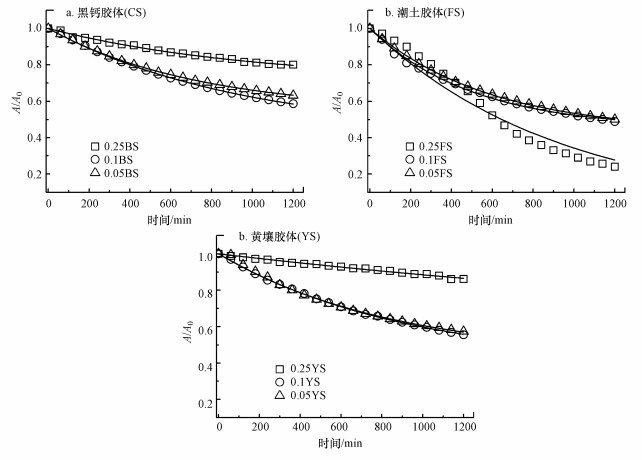 |
| 图 1 不同离子强度影响下土壤胶体的沉降曲线及拟合曲线 Fig. 1Settlement curves and exponential-model-fitted curves of soil colloids under different ionic strength |
表 6(Table 6)
| 表 6 不同条件下土壤胶体的沉降拟合参数 Table 6 Exponential-model-fitted parameters of soil colloids and mixed soil colloid-HA at pH 4.0, 7.0 and 9.0 | |||||||||||||||||||||||||||||||||||||||||||||||||||||||||||||||||||||||||||||||||||||||||||||||||||||||||||||||||||||||||||||||||||||||||||||||||||||||||||||||||||||||||||||||||||||||||||
表 6 不同条件下土壤胶体的沉降拟合参数 Table 6 Exponential-model-fitted parameters of soil colloids and mixed soil colloid-HA at pH 4.0, 7.0 and 9.0
| |||||||||||||||||||||||||||||||||||||||||||||||||||||||||||||||||||||||||||||||||||||||||||||||||||||||||||||||||||||||||||||||||||||||||||||||||||||||||||||||||||||||||||||||||||||||||||
3.3 胡敏酸的影响3.3.1 浓度效应不同浓度HA下土壤胶体的沉降曲线及拟合曲线如图 2所示, 拟合参数见表 6.总体来说, HA增强土壤胶体的稳定性, 因为有机质能增加土壤胶体表面的负电荷, 通过提高静电斥力而增强其稳定性(Jekel, 1986;Zhu et al., 2017).Ahmad(2016)在研究富里酸对纳米零价铁胶体稳定性的影响时也得出了类似的结论.其中, HA对潮土胶体稳定性的影响较大, 而对黑钙土和黄壤胶体稳定性影响相对较小, 可能是因为黑钙土和黄壤本身分别含有较多带负电荷的有机质和黏土矿物胶体, 因此同样带负电HA的加入对这些胶体稳定性的影响有限, 而潮土胶体体系则相对易受到影响, 稳定性明显提升(Chen et al., 2020).随着HA浓度从0 mg·L-1升高至50 mg·L-1, 黑钙土、潮土和黄壤胶体的拟合C′res值分别由0.375、0.384和0.432升高至0.470、0.610和0.481(表 6), 且黑钙土和黄壤胶体的负Zeta电位由22.1 mV、29.7 mV上升至40.6 mV、42.4 mV(表 3), 表明3种土壤胶体的稳定性逐渐增强, Fang等(2009)的研究也表明了增加有机质含量显著提升纳米TiO2的稳定性.
图 2(Fig. 2)
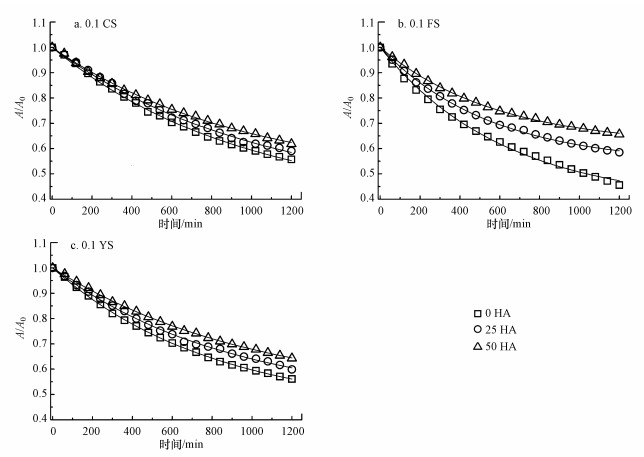 |
| 图 2 不同浓度HA影响下土壤胶体的沉降曲线及拟合曲线 Fig. 2Settlement curves and exponential-model-fitted curves of soil colloids under different humic acid concentrations |
3.3.2 粒径效应相对于纯土壤胶体体系, 加入大粒径HA显著提高了土壤胶体的稳定性, 且不受pH的影响(图 3a~3c).过膜后, 由于大粒径HA的滤除, F-HA的粒径为0~100 nm.相对于添加大粒径HA的土壤胶体体系, 酸性条件下, F-HA对3种土壤胶体的稳定性均略有提高(图 3d~3e), 其中黑钙土、潮土和黄壤胶体的粒径分别由498.0、396.8、561.3 nm减小至392.9、335.6和402.8 nm(表 3), 拟合Vs值也分别由0.854×103、1.750×103、0.923×103 m·h-1降低至0.623×103、1.050×103、0.325×103 m·h-1(表 6);而在中、碱性条件下, F-HA则略微降低了土壤胶体的稳定性, 3种土壤胶体的粒径增加、负Zeta电位值降低(表 3)、拟合C′res值也有所降低(表 6).HA在酸性条件下主要呈颗粒状结构, 而碱性条件下则以链状结构为主(Kai et al., 2007).酸性条件下, 相对于HA, F-HA的自身稳定性更强, 同时带负电的F-HA也会自凝聚形成更大的颗粒结构, 有利于土壤胶体稳定性的提升.Song等(2019)的研究也指出有机质粒径的增加更能提高纳米基苯乙烯塑料颗粒的稳定性.而中、碱性条件下, 相对于HA, F-HA产生的链状凸起结构相对较小, 故导致空间弹性斥力和渗透性斥力减弱, 土壤胶体的稳定性略有降低(马杰, 2016).
图 3(Fig. 3)
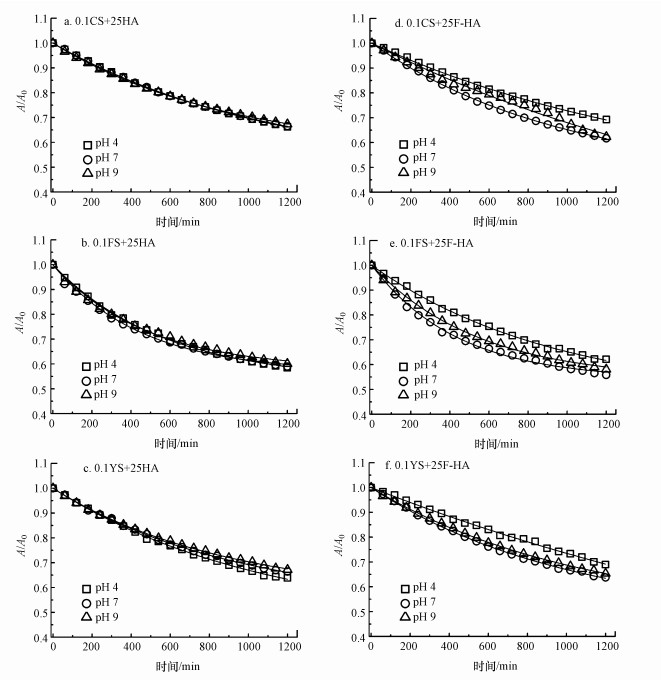 |
| 图 3 不同粒径HA影响下的土壤胶体沉降曲线及拟合曲线(a、b、c代表大粒径HA影响下土壤胶体的沉降及拟合曲线(引自参考文献(Chen et al., 2020), d、e、f代表F-HA影响下土壤胶体的沉降及拟合曲线) Fig. 3Settlement curves and exponential-model-fitted curves of soil colloids under different particle sizes of humic acid |
3.4 DLVO理论解析土壤胶体的稳定性基于DLVO理论, 当胶体之间相距较远时, 胶体间范德华引力和静电斥力都趋近于0, 胶体间的作用力虽为负值, 但绝对值很小, 胶体间的作用力并不明显;随着距离的逐渐接近, 土壤胶体陷入次级势阱, 胶体会发生可逆的聚集, 尤其是溶液离子强度降低的情况下, 随着次级势阱的逐渐消失, 聚集的胶体可再次被分散(Franchi et al., 2003;Hahn et al., 2004a;2004b;Redman et al., 2004);当两个胶体更接近时, 由于扩散层大范围重叠, 双电子层斥力逐渐增大, 胶体间作用力逐渐上升为正值并出现峰值, 达到一级势垒, 当一级势垒相对较高时, 胶体间逐渐靠近, 相互斥力逐渐增大, 两胶体不易进一步靠近而相互分散.不同离子强度下土壤胶体的相互作用能随分离距离的变化如图 4所示, 能量位垒见表 7.高离子强度下(称样量为0.25 g), 黑钙土和黄壤胶体的一级势垒达到最高(分别为71.49 kT和110.63 kT), 而潮土胶体的一级势垒达到最低且在0以下, 与沉降曲线结果一致, 即此时的黑钙土和黄壤胶体表现出很强的稳定性, 而潮土胶体较易克服势垒作用并发生团聚.当称样量减少时, 3种土壤胶体在最低离子强度(0.05 g称样量)下的一级势垒明显更高, 很容易判断出此时的土壤胶体具有相对强的稳定性, 因此联合DLVO理论可以更好的评价胶体溶液的稳定性.
图 4(Fig. 4)
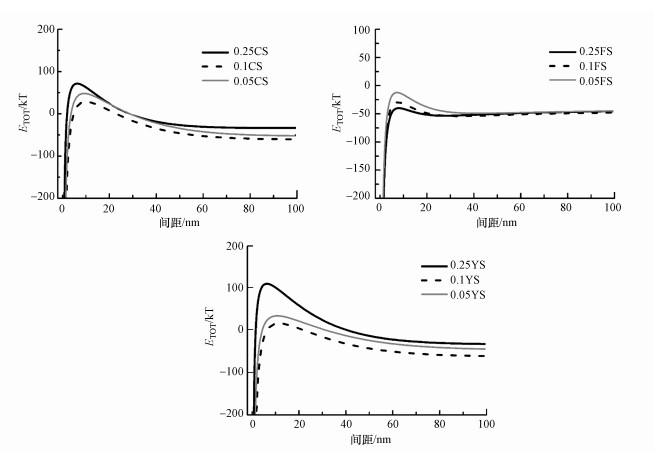 |
| 图 4 不同离子强度影响下土壤胶体的相互作用能随分离距离的变化 Fig. 4The interaction energy curves between soil colloids under different ionic strength |
表 7(Table 7)
| 表 7 不同沉降体系的能量位垒 Table 7 The DLVO energy barriers for different settling systems | ||||||||||||||||||||||||||||||||||||||||||||||||||||||||||||||||||||||||||||||||||||||||||||||||||||||||
表 7 不同沉降体系的能量位垒 Table 7 The DLVO energy barriers for different settling systems
| ||||||||||||||||||||||||||||||||||||||||||||||||||||||||||||||||||||||||||||||||||||||||||||||||||||||||
中性条件(pH=7)下, 随着胡敏酸浓度的升高, 黑钙土和黄壤胶体的负Zeta电位值增大(表 3), 其一级势垒也随之增加至600 kT左右(表 7、图 5), 故这两种胶体很难克服势垒作用而发生聚集, 所以胶体稳定性增强.而潮土胶体的一级势垒值一直小于0.当第一势垒不存在或很小时, 胶体的热运动则完全可以克服能垒, 且胶体间的范德华引力会随着颗粒间距离的减小而剧增, 颗粒将趋向于絮凝(王智巧等, 2020), 所以潮土胶体的沉降速率相对较大(表 6), 更倾向聚沉.
特定的HA浓度(HA=25 mg·L-1)下, 加入大粒径的HA后, 随着pH值的增加, 土壤胶体的一级势垒增加(表 7、图 6a~6c), 结合粒径、Zeta电位以及沉降曲线特性分析(表 3、图 3), 可以判断3种土壤胶体的稳定性增强.相对于大粒径HA, 酸性条件下, 加入F-HA后黑钙土和黄壤胶体的一级势垒分别由11.82、50.18 kT提高至76.4、102.26 kT(表 7), 潮土胶体的一级势垒虽然依然小于0, 但3种胶体的粒径均减小(表 3), 由此可知此条件下3种土壤胶体稳定性增强;而在中、碱性条件下, 黑钙土和黄壤胶体的一级势垒均有所减小且潮土胶体的一级势垒降低至0以下(表 7), 故胶体更易克服势垒作用而发生凝聚, 加之胶体的粒径增加、负Zeta电位值和拟合C′res降低(表 3、表 6), 使得3种土壤胶体的稳定性减弱.
图 5(Fig. 5)
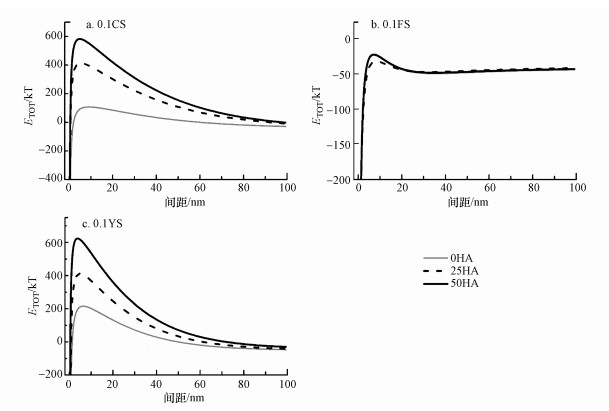 |
| 图 5 不同浓度HA影响下土壤胶体的相互作用能随分离距离的变化 Fig. 5The interaction energy curves of soil colloids under different humic acid concentrations |
图 6(Fig. 6)
 |
| 图 6 HA和F-HA影响下土壤胶体的相互作用能随分离距离的变化(HA数据引自参考文献(Chen et al., 2020)) Fig. 6The interaction energy curves of soil colloids under HA and F-HA |
4 结论(Conclusions)1) 即使在高离子强度下, 黑钙土和黄壤胶体因有机质和黏土矿物含量较高, 表面负电荷多、静电斥力大, 故稳定性好;而潮土胶体则在低离子强度下才表现出较高的稳定性.
2) HA通过增加土壤胶体表面的负电荷, 提高胶体间静电斥力而增强其稳定性, 且3种不同土壤胶体的稳定性均随着HA浓度的升高而增强.相比于大粒径HA, 在酸性条件下, F-HA稳定性更强, 且通过自凝聚形成较大的团聚体来提高土壤胶体的稳定性;在中、碱性条件下, F-HA产生的链状凸起结构相对较小, 导致空间弹性斥力和渗透性斥力减弱, 进而降低了土壤胶体的稳定性.
参考文献
| Ahmad K. 2016. 铜离子/富里酸对纳米零价铁胶体稳定性、迁移性和反应活性的影响研究[D]. 长沙: 湖南大学 |
| Barton C, Karathanasis A. 2003. Influence of soil colloids on the migration of atrazine and zinc through large soil monoliths[J]. Water Air and Soil Pollution, 143: 3-21. DOI:10.1023/A:1022886225564 |
| Chen Y L, Ma J, Li Y T, et al. 2019. Enhanced cadmium immobilization in saturated media by gradual stabilization of goethite in the presence of humic acid with increasing pH[J]. Science of the Total Environment, 648: 358-366. DOI:10.1016/j.scitotenv.2018.08.086 |
| Calero J, Ontiveros-Ortega A, Aranda V, et al. 2017. Humic acid adsorption and its role in colloidal-scale aggregation determined with the zeta potential, surface free energy and the extended-DLVO theory[J]. European Journal of Soil Science, 68(4): 491-503. DOI:10.1111/ejss.12431 |
| Chappell M A, George A J, Dontsova K M, et al. 2009. Surfactive stabilization of multi-walled carbon nanotube dispersions with dissolved humic substances[J]. Environmental Pollution, 157(4): 1081-1087. DOI:10.1016/j.envpol.2008.09.039 |
| 陈忠柳. 2020. 喀斯特山区土壤阳离子交换性能对土地不同利用方式的响应[D]. 贵州: 贵州大学 |
| Chen Y L, Ma J, Wu X J, et al. 2020. Sedimentation and transport of different soil colloids: Effects of goethite and humic acid[J]. Water, 12(4): 980. DOI:10.3390/w12040980 |
| Fang J, Shan X Q, Wen B, et al. 2009. Stability of titania nanoparticles in soil suspensions and transport in saturated homogeneous soil columns[J]. Environmental Pollution, 157(4): 1101-1109. DOI:10.1016/j.envpol.2008.11.006 |
| Franchi A, O'Melia C R. 2003. Effects of natural organic matterand solution chemistry on the deposition and reentrainment of colloids in porous media[J]. Environmental Science & Technology, 37(6): 1122-1129. |
| 郭新送, 宋付朋, 鞠正山. 2015. 不同土水比土壤浸提液与饱和泥浆电导率的比较研究[J]. 土壤, 47(4): 812-818. |
| Gregory J. 1981. Approximate expressions for retarded van der waals interaction[J]. Journal of Colloid & Interface Science, 83(1): 138-145. |
| Hahn M W, Abadzic D, O'Melia C R. 2004a. Aquasols: On the role of secondary minima[J]. Environmental Science & Technology, 38(22): 5915-5924. |
| Hahn M W, O'Meliae C R. 2004b. Deposition and reentrainment of brownian particles in porous media under unfavorable chemical conditions: Some concepts and applications[J]. Environmental Science & Technology, 38(1): 210-220. |
| 胡琼英, 兰叶青. 1996. 土壤胶体稳定性影响因素[J]. 土壤, 28(6): 290-294. |
| 胡俊栋, 沈亚婷, 王学军. 2009. 离子强度、pH对土壤胶体释放、分配沉积行为的影响[J]. 生态环境学报, (2): 235-243. |
| Igwe C A, Akamigbo F O R, Mbagwu J S C. 1999. Chemical and mineralogical properties of soils in southeastern Nigeria in relation to aggregate stability[J]. Geoderma, 92(1/2): 0-123. |
| Jonge L W D, Kjaergaard C, Moldrup P. 2004. Colloids and colloid-facilitated transport of contaminants in soils: An introduction[J]. Vadose Zone Journal, 3(2): 321-325. DOI:10.2136/vzj2004.0321 |
| Jin X, Li M H, Wang J W, et al. 2010. High-throughput screening of silver nanoparticle stability and bacterial inactivation in aquatic media: influence of specific ions[J]. Environmental Science & Technology, 19(44): 7321-7328. |
| Jekel M R. 1986. The stabilization of dispersed mineral particles by adsorption of humic substances[J]. Water Research, 20(12): 1543-1554. DOI:10.1016/0043-1354(86)90119-3 |
| Kretzschmar R, Holthoff H, Sticher H. 1998. Influence of pH and humic acid on coagulation kinetics of kaolinite: A dynamic light scattering study[J]. Journal of Collloid & Interface Science, 202(1): 95-103. |
| Kosmulski M. 2012. IEP as a parameter characterizing the pH-dependent surface charging of materials other than metal oxides[J]. Advances in Colloid and Interface Science, 171-172: 77-86. DOI:10.1016/j.cis.2012.01.005 |
| Kai L C, Elimelech M. 2007. Influence of humic acid on the aggregation kinetics of fullerene (C60) nanoparticles in monovalent and divalent electrolyte solutions[J]. Journal of Colloid and Interface Science, 309(1): 126-134. DOI:10.1016/j.jcis.2007.01.074 |
| Lin D H, Ji J, Long Z F, et al. 2012. The influence of dissolved and surface-bound humic acid on the toxicity of TiO nanoparticles to Chlorella sp[J]. Water Research, 46(14): 4477-4487. DOI:10.1016/j.watres.2012.05.035 |
| Long Z F, Ji J, Yang K, et al. 2012. Systematic and quantitative investigation of the mechanism of carbon nanotubes' toxicity toward algae[J]. Environmental Science & Technology, 46(15): 8458-8466. |
| 林道辉. 2016. 溶解性有机质与纳米颗粒的相互作用及其环境意义[C]. 中国化学会第30届学术年会-第二十六分会: 环境化学. 大连 |
| 刘冠男, 刘新会. 2013. 土壤胶体对重金属运移行为的影响[J]. 环境化学, 32(7): 1308-1317. |
| Ma J, Guo H M, Lei M, et al. 2016. Blocking effect of colloids on arsenate adsorption during co-transport through saturated sand columns[J]. Environmental Pollution, 213: 638-647. DOI:10.1016/j.envpol.2016.03.020 |
| Ma J, Lei M, Weng L P, et al. 2019. Fractions and colloidal distribution of arsenic associated with iron oxide minerals in lead-zinc mine-contaminated soils: Comparison of tailings and smelter pollution[J]. Chemosphere, 227: 614-623. DOI:10.1016/j.chemosphere.2019.04.030 |
| Ma J, Guo H M, Lei M, et al. 2018. Enhanced transport of ferrihydrite colloid by chain-shaped humic acid colloid in saturated porous media[J]. Science of the Total Environment, 621: 1581-1590. DOI:10.1016/j.scitotenv.2017.10.070 |
| 马杰. 2016. 砷在含水介质中迁移转化的胶体效应[D]. 北京: 中国地质大学(北京) |
| Redman J A, Walker S L, Elimelech M. 2004. Bacterial adhesion and transport in porous media: Role of the secondary energy minimum[J]. Environmental Science & Technology, 38(6): 1777-1785. |
| 商书波, 王丰雨, 李绪谦. 2010. 土壤胶体理化性质对其稳定性和可移动性的影响研究[J]. 土壤, 42(6): 1015-1019. |
| Suarez D L, Rhoades J D, Lavado R, et al. 1984. Effect of pH on saturated hydraulic conductivity and soil dispersion[J]. Soil Science Society of America Journal, 48(1): 50-55. DOI:10.2136/sssaj1984.03615995004800010009x |
| Saxena K, Brighu U, Choudhary A. 2019. Coagulation of humic acid and kaolin at alkaline pH: Complex mechanisms and effect of fluctuating organics and turbidity[J]. Journal of Water Process Engineering, 31: 100875. DOI:10.1016/j.jwpe.2019.100875 |
| Song Z F, Yang X Y, Chen F M, et al. 2019. Fate and transport of nanoplastics in complex natural aquifer media: Effect of particle size and surface functionalization[J]. Science of the Total Environment, 669: 120-128. DOI:10.1016/j.scitotenv.2019.03.102 |
| Valdrighi M M, Pera A, Agnolucci M, et al. 1996. Effects of compost-derived humic acids on vegetable biomass production and microbial growth within a plant (Cichorium intybus)-soil system: A comparative study[J]. Agriculture Ecosystems & Environment, 58(2/3): 133-144. |
| 王智巧, 马杰, 陈雅丽, 等. 2020. 不同环境条件下水铁矿和针铁矿纳米颗粒稳定性[J]. 环境科学, 41(5): 2292-2300. |
| 徐绍辉, 刘庆玲. 2010. 饱和多孔介质中胶体沉淀释放过程的数值模拟[J]. 高校地质学报, (1): 28-33. |
| Yu Z H, Zhang J B, Zhang C Z, et al. 2017. The coupling effects of soil organic matter and particle interaction forces on soil aggregate stability[J]. Soil & Tillage Research, 174: 251-260. |
| 杨耘博, 王威, 王赟, 等. 2019. 天然土壤胶体对U(Ⅵ)迁移的影响[J]. 核化学与放射化学, 41(4): 391-398. |
| 张鑫慧. 2013. 典型热带地区土壤发育过程中的胶体稳定性及其土壤发生意义[D]. 北京: 中国科学院大学 |
| 张凡, 张永祥, 王祎啸. 2019. 基于DLVO理论探究不同因素下土壤胶体迁移堵塞问题[J]. 山东化工, 48(13): 227-231. DOI:10.3969/j.issn.1008-021X.2019.13.095 |
| Zhao W Q, Walker S L, Huang Q Y, et al. 2014. Adhesion of bacterial pathogens to soil colloidal particles: Influences of cell type, natural organic matter, and solution chemistry[J]. Water Research, 53: 35-46. DOI:10.1016/j.watres.2014.01.009 |
| Zhu X, Chen H, Li W, et al. 2017. Evaluation of the stability of soil nanoparticles: the effect of natural organic matter in electrolyte solutions[J]. European Journal of Soil Science, 68(1): 105-11. DOI:10.1111/ejss.12402 |
